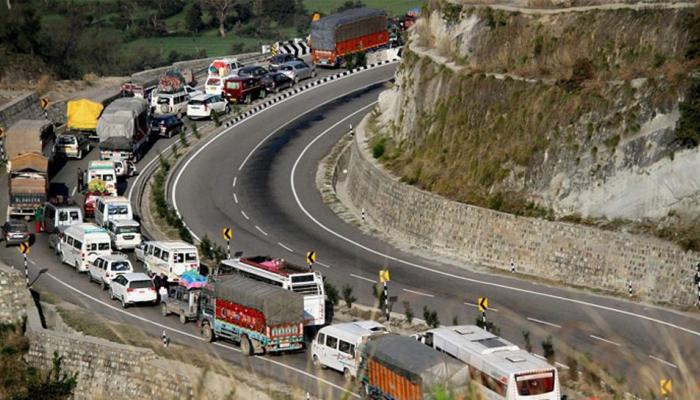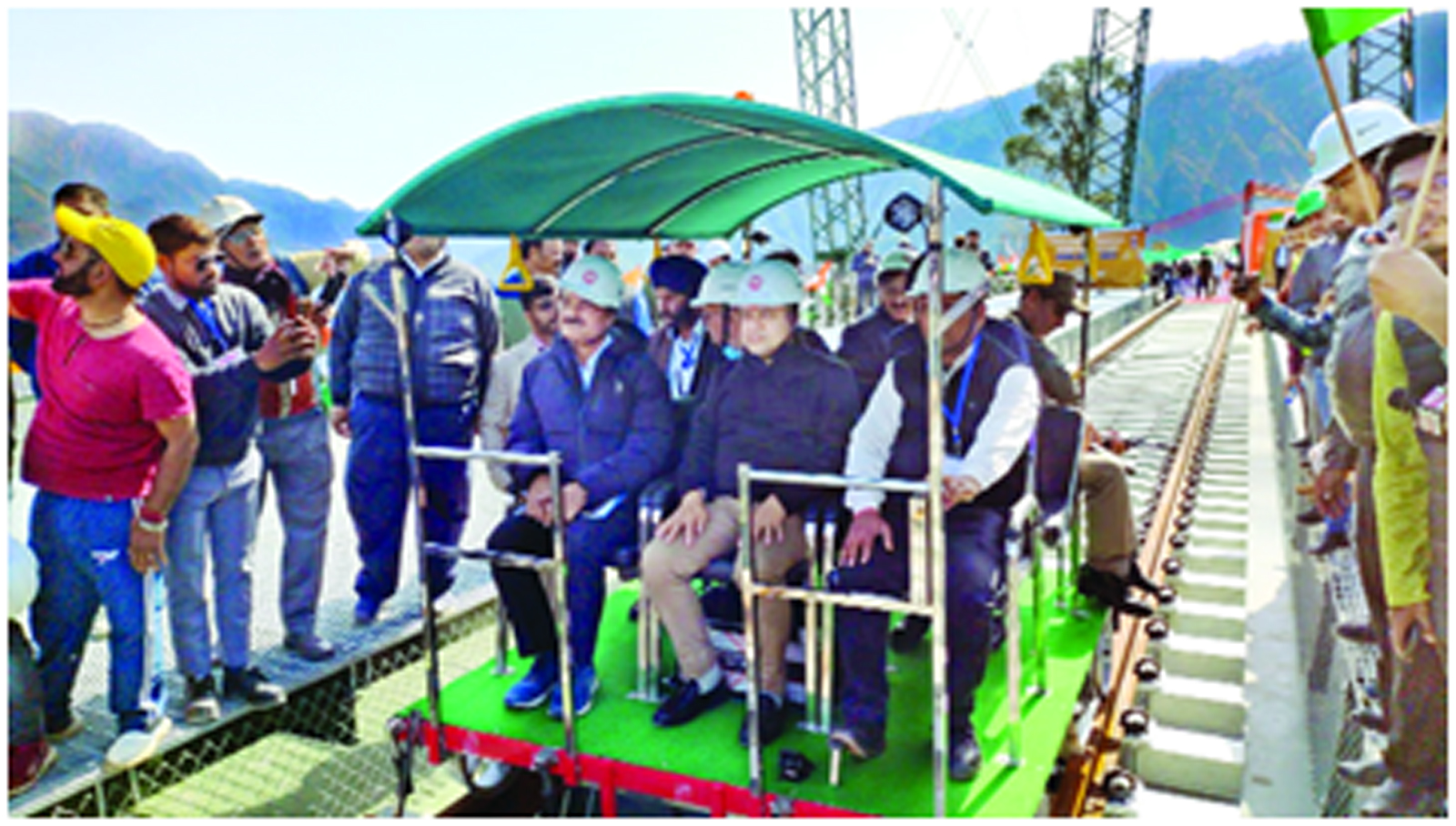Lifeline Under Stress
By: Javid Amin | 11 September 2025
The Srinagar-Jammu National Highway (NH-44) is not just a road; it is Kashmir’s economic lifeline, the only all-weather surface link connecting the Valley with the rest of India. Every truck, every apple-laden vehicle, every fuel tanker that makes its way through this mountainous stretch sustains the economy of the region.
But once again, nature and geography have tested its resilience. A massive landslide and road sinking at Tharad in Udhampur district have left the highway partially functional, with traffic regulated on a rotational basis. For the last several days, stranded vehicles, endless congestion, and delayed supplies have become the story of thousands.
In this article, we break down the full picture: the current situation, challenges faced by commuters, the impact on Kashmir’s economy, particularly the apple industry, and the future of highway connectivity in the region.
Current Status: Highway Partially Open, But With Restrictions
According to official sources, traffic on the Srinagar-Jammu National Highway is being managed rotationally at Tharad between Chenani and Udhampur, where nearly 250 meters of road stretch suffered severe damage.
-
Morning hours: Light Motor Vehicles (LMVs) were permitted to cross the landslide-affected zone using a temporary diversion.
-
Daytime: Heavy Motor Vehicles (HMVs), particularly trucks carrying fuel, food supplies, and construction material, were allowed passage.
-
Evening: Apple-laden trucks, stranded for over 16 days at Qazigund, were finally permitted to move towards Jammu, bringing relief to desperate orchard owners.
While partial restoration has helped ease pressure, the highway is not fully functional. Authorities confirm that the Chenani-Udhampur stretch continues to face landslides, slippery conditions, and sinking patches, making it unsafe for two-way traffic.
The Struggle of Stranded Vehicles
Long Waits & Uncertainty
Drivers and commuters report being stuck in traffic for hours—sometimes even days. Congestion at narrow diversion points, combined with one-way movement, makes travel slow, risky, and unpredictable.
Advocate Khursheed Wani, who traveled from Banihal to Jammu, described his ordeal:
-
He left Banihal at 7 AM and reached Nashri in just an hour.
-
But police halted traffic there due to safety concerns.
-
A sinking road tube on the Chenani-Udhampur stretch forced authorities to divert traffic onto a muddy, slippery track, unsuitable for smooth movement.
He warned fellow commuters: “Travel only if it is an emergency. The road is unsafe, delays are long, and risks are high.”
Psychological Toll
For truckers, being stranded is not just about delays; it’s about survival. Limited access to food, drinking water, and shelter in highway zones like Ramban, Chenani, and Banihal has become a recurring nightmare. Many drivers rely on roadside eateries, which often run short of supplies themselves due to the same roadblock.
Kashmir’s Apple Economy Takes a Hit
Kashmir is Asia’s largest apple producer, contributing nearly 75% of India’s apple output. Every September to November, thousands of trucks loaded with apples move out of Kashmir towards Delhi, Mumbai, and other markets.
But this year, the Tharad blockade trapped apple trucks for over two weeks. The consequences are devastating:
-
Fruit rotting in trucks: Apples are perishable, and delays of even 3–4 days can cause loss of freshness and market value. Sixteen days meant major losses.
-
Market disruptions: Delayed arrivals in wholesale markets lead to falling prices for Kashmiri growers, while imported apples gain a competitive edge.
-
Supply chain breakdown: Cold storage facilities are limited in Kashmir, forcing farmers to depend on timely transportation. With trucks stuck, cold storage remained underutilized.
The Kashmir Valley Fruit Growers Association has already raised alarm, urging authorities to prioritize apple trucks in traffic management. For farmers who rely on this seasonal income, each lost truckload equals months of hard work wasted.
Safety Concerns on the Chenani-Udhampur Stretch
The Chenani-Udhampur sector is currently the weakest link in NH-44. According to commuters:
-
One tube of the Chenani-Nashri stretch has sunk, showing visible cracks.
-
A makeshift diversion, muddy and narrow, is the only passage available.
-
Frequent landslides, triggered by rains, keep blocking the road.
-
Heavy vehicles often get stuck in slush, causing further congestion.
Experts say the highway in this area is highly landslide-prone because of weak soil composition and haphazard construction. The Udhampur-Ramban-Banihal sector has always been considered a “red zone” for road engineers.
Traffic Advisory & Government Response
The J&K Traffic Police issued repeated advisories:
-
Travel only after checking road status with Traffic Control Units (Srinagar, Jammu, Udhampur, Ramban).
-
Avoid traveling against advisory timings.
-
Follow strict lane discipline to prevent further congestion.
-
Do not overtake on narrow diversion tracks.
Information is being updated regularly on the Traffic Police X (Twitter) handle and their Facebook page.
Meanwhile, the National Highways Authority of India (NHAI) and district administration are working to restore full connectivity. Bulldozers, cranes, and workers remain deployed round-the-clock. However, officials admit that full restoration may take several more days, depending on weather stability.
Natural Challenges: Rain, Landslides & Fragile Terrain
The Jammu-Srinagar highway runs through the Pir Panjal mountain range, making it one of the most geologically fragile routes in South Asia.
-
Rainfall: Continuous rains loosen soil and trigger landslides.
-
Mountain cutting: Ongoing construction weakens slopes.
-
River erosion: Chenab and its tributaries wash away road support.
The highway has faced repeated closures this year, raising questions on whether temporary repairs are enough or if permanent solutions like tunnels should be expedited.
Socioeconomic Impact of Highway Closures
1. Essential Supplies Disrupted
-
Fuel shortages in Kashmir lead to rationing.
-
Vegetables, poultry, and medicines see price hikes.
2. Tourism Industry Affected
-
With uncertainty on road travel, tourists prefer flights, making Srinagar airfares skyrocket.
-
Domestic tourists driving in from Delhi, Punjab, or Himachal cancel trips.
3. Daily Wage Workers Suffer
Highway towns like Ramban and Banihal thrive on traffic. When vehicles stop moving, dhabas, mechanics, porters, and small vendors lose income.
The Road Ahead: Need for Long-Term Solutions
Experts suggest multiple strategies:
-
Early Completion of Tunnels
-
The Z-Morh and Zojila tunnels on Srinagar-Leh road are examples of permanent solutions.
-
Similar projects in Ramban and Udhampur sectors could bypass landslide zones.
-
-
Geo-Engineering Measures
-
Strengthening slopes with retaining walls, vegetation, and advanced drainage systems.
-
-
Alternative Highways
-
The Mughal Road (Shopian–Poonch) and Sinthan Road (Anantnag–Kishtwar) should be upgraded to national highway status for emergency use.
-
-
Logistics Reform
-
Cold storage hubs in Kashmir.
-
Dedicated rail freight corridors for apples and essentials.
-
Bottom-Line: A Road That Defines Kashmir’s Future
The Srinagar-Jammu National Highway is more than asphalt and concrete—it is the heartbeat of Kashmir. Every closure, every landslide, every delay sends ripples through homes, markets, and orchards.
As the highway remains partially open at Tharad, the message is clear: Kashmir needs resilient infrastructure, not patchwork fixes. Until then, drivers, commuters, farmers, and traders will continue to live with uncertainty, praying that their lifeline doesn’t snap again tomorrow.


